Rafah
Rafah (Arabic: رفح – Rafaḥ) is a Palestinian city and refugee camp in the southern Gaza Strip. It is the district capital of the Rafah Governorate, located 30 kilometers (19 mi) south of Gaza City. Rafah's population of 152,950 (2014) is overwhelmingly made up of Palestinian refugees. Rafah camp and Tall as-Sultan camp form separate localities.
Rafah | |
|---|---|
Municipality type A (City) | |
| Arabic transcription(s) | |
| • Arabic | رَفَح |
| Hebrew transcription(s) | |
| • Hebrew | רָפִיחַ |
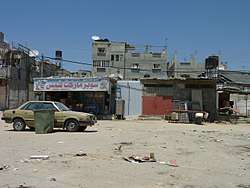 | |
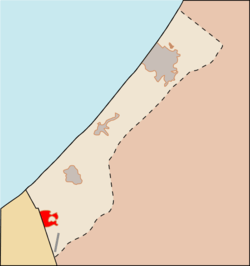 Location of Rafah in the Gaza Strip | |
 Rafah Location of Rafah within Palestine | |
| Coordinates: 31°17′19″N 34°15′07″E | |
| Palestine grid | 77/78 |
| State | State of Palestine |
| Governorate | Rafah |
| Government | |
| • Type | City |
| • Head of Municipality | Anwar al-Shaer (2019)[1] |
| Population (2014)[2] | |
| • Total | 152,950 |
When Israel withdrew from the Sinai in 1982, Rafah was split into a Gazan part and an Egyptian part, dividing families, separated by barbed-wire barriers.[3][4] The core of the city was destroyed by Israel[5][6][7] and Egypt[8][9] to create a large buffer zone.
Rafah is the site of the Rafah Border Crossing, the sole crossing point between Egypt and the State of Palestine. Gaza's only airport, Yasser Arafat International Airport, was located just south of the city. The airport operated from 1998 to 2001, until it was bombed and bulldozed by the Israeli military (IDF) after the killing of Israeli soldiers by members of Hamas.
Etymology
Over the ages it has been known as "Robihwa" by the ancient Egyptians, "Rafihu" by the Assyrians, "Ῥαφία, Rhaphia"[10] by the Greeks, "Raphia" by Romans, רפיח "Rafiaḥ" by the Israelites, "Rafh" by the Arab Caliphate. The transliteration of the Hebrew name, "Rafiah", is used in modern English alongside "Rafah"[11][12]
Development
The Ottoman–British agreement of 1 October 1906 established a boundary between Ottoman ruled Palestine and British ruled Egypt, from Taba to Rafah. After World War I Palestine was also under British control, but the Egypt-Palestine Boundary was maintained to control movement of the local Bedouin. From the mid-1930s the British enhanced the border control and Rafah evolved as a small boundary town which functioned as a trade and services centre for the semi-settled Beduin population.[4] During the Second World War it became an important British base.
Following the Armistice Agreement of 24 February 1949, Rafah was located in Egypt-occupied Gaza and consequently, a Gaza–Egypt border did no longer exist. Rafah could grow without any consideration being taken of the old 1906 international boundary.[4] In the 1967 Six-Day War, Israel conquered the Sinai Peninsula and the Gaza Strip from Egypt and all of the city now was under Israeli occupation.
In 1979, Israel and Egypt signed a peace treaty that returned the Sinai, which borders the Gaza Strip, to Egyptian control. In the Peace Treaty, the re-created Gaza–Egypt border was drawn across the city of Rafah. Rafah was divided into an Egyptian and a Palestinian part, splitting up families, separated by barbed-wire barriers. Families were separated, property was divided and many houses and orchards were cut across and destroyed by the new boundary, bulldozed, allegedly for security reasons. Rafah became one of the three border points between Egypt and Israel.[3][4]
Demographics
In 1922, Rafah's population was 599,[13] which increased to 2,220 in 1945.[14] In 1982, the total population was approximately 10,800.[15]
In the 1997 Palestinian Central Bureau of Statistics (PCBS) census, Rafah and its adjacent camp had a combined population of 91,181, Tall as-Sultan was listed with a further 17,141.[16] Refugees made up 80.3% of the entire population.[17] In the 1997 census, Rafah's (together with Rafah camp) gender distribution was 50.5% male and 49.5% female.[18]
In the 2006 PCBS estimate, Rafah city had a population of 71,003,[19] Rafah camp and Tall as-Sultan form separate localities for census purposes, having populations of 59,983 and 24,418, respectively.[19]
Archaeology
Antiochus III willing to make peace with Ptolemy V, had his daughter Cleopatra I marry Ptolemy V. Their marriage took place in 193 BC in Raphia[20]
History
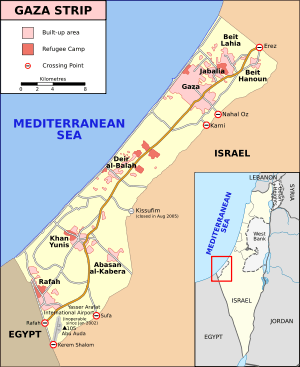
Rafah has a history stretching back thousands of years. It was first recorded in an inscription of Egyptian Pharaoh Seti I, from 1303 BCE as Rph, and as the first stop on Pharaoh Shoshenq I's campaign to the Levant in 925 BCE. In 720 BCE it was the site of the Assyrian king Sargon II's victory over the Egyptians, and in 217 BCE the Battle of Raphia was fought between the victorious Ptolemy IV and Antiochus III.[21] (It is said to be one of the largest battles ever fought in the Levant, with over a hundred thousand soldiers and hundreds of elephants).
The town was conquered by Alexander Yannai and held by the Hasmoneans until it was rebuilt in the time of Pompey and Gabinius; the latter seems to have done the actual work of restoration for the era of the town dates from 57 BCE. Rafah is mentioned in Strabo (16, 2, 31), the Antonine Itinerary, and is depicted on the Map of Madaba.[21]
During the Byzantine period, it was a diocese,[21][22] and Byzantine ceramics and coins have been found there.[23] It was represented at the Council of Ephesus 431 CE by Bishop Romanus, but today remains a titular see of the Roman Catholic Church[24] but a small Greek Orthodox presence exists.
Arab and Mamluk rule
Rafah was an important trading city during the early Arab period, and one of the towns captured by the Rashidun army under general 'Amr ibn al-'As in 635 CE.[25] Under the Umayyads and Abbasids, Rafah was the southernmost border of Jund Filastin ("District of Palestine"). According to Arab geographer al‑Ya'qubi, it was the last town in the Province of Syria and on the road from Ramla to Egypt.[26]
A Jewish community settled in the city in the 9th and 10th centuries and again in the 12th, although in the 11th century it suffered a decline and in 1080 they migrated to Ashkelon. A Samaritan community also lived there during this period. Like most cities of southern Palestine, ancient Rafah had a landing place on the coast (now Tell Rafah), while the main city was inland.[21]
In 1226, Arab geographer Yaqut al-Hamawi writes of Rafah's former importance in the early Arab period, saying it was "of old a flourishing town, with a market, and a mosque, and hostelries". However, he goes on to say that in its current state, Rafah was in ruins, but was an Ayyubid postal station on the road to Egypt after nearby Deir al‑Balah.[26]
Ottoman and Egyptian period
Rafah appeared in the 1596 Ottoman tax registers as being in the Nahiya of Gaza of the Liwa of Gazza. It had a population of 15 households, all Muslim, who paid taxes on wheat, barley, summer crops, occasional revenues, goats and/or bee hives.[27]
In 1799, the Revolutionary Army of France commanded by Napoleon Bonaparte passed through Rafah during the invasion of Egypt and Syria.[28]
Rafah was the boundary between the provinces of Egypt and Syria. In 1832, the area came under Egyptian occupation of Muhammad Ali, which lasted until 1840.
The French explorer Victor Guérin, who visited in May 1863, noted two pillars of granite which the locals called Bab el Medinet, meaning "The Gate of the town".[29] In 1881, Archduke Ludwig Salvator of Austria wrote: "Fragments of gray granite pillars, still standing, are here to be met with about the road, the fields, and the sand, and we saw one lying on the ground half buried... The pillars are the remains of an ancient temple, Raphia, and are of special importance in the eyes of the Arabs, who call them Rafah, as they mark the boundary between Egypt and Syria."[30]
British mandate era
In 1917, the British army captured Rafah, and used it as a base for their attack on Gaza. The presence of the army bases was an economic draw that brought people back to the city.
In the 1922 census of Palestine conducted by the British Mandate authorities, Rafah had a population of 599 inhabitants, all Muslim,[13] increasing in the 1931 census to 1,423, still all Muslims, in 228 houses.[31]
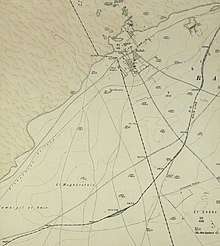
In the 1945 statistics Rafah had a population of 2,220, all Muslims,[32] with 40,579 dunams of land, according to an official land and population survey.[14] Of this, 275 dunams were plantations and irrigable land, 24,173 used for cereals,[33] while 16,131 dunams were un-cultivable land.[34]
1948–1967
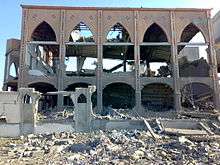
After the 1948 Arab–Israeli War, Egypt governed the area (see Palestinian Protectorate) and refugee camps were established. In the 1956 war involving Israel, Britain, France, and Egypt, 111 people, including 103 refugees, were killed by the Israeli army in the Palestinian refugee camp of Rafah, during the Rafah massacre. The United Nations was unable to determine the circumstances surrounding the deaths.[35][36]
During the 1967 Six-Day War, the Israel Defense Forces captured Rafah with the Sinai Peninsula and Gaza Strip, the population was about 55,000, of whom only 11,000 lived in Rafah itself.
After 1967
In the summer of 1971, the IDF, under General Ariel Sharon (then head of the IDF southern command), destroyed approximately 500 houses in the refugee camps of Rafah in order to create patrol roads for Israeli forces. These demolitions displaced nearly 4,000 people.[37] Israel established the Brazil and Canada housing projects to accommodate displaced Palestinians and to provide better conditions in the hopes of integrating the refugees into the general population and its standard of living;[38] Brazil is immediate south of Rafah, while Canada was just across the border in Sinai. Both were named because UN peacekeeping troops from those respective countries had maintained barracks in those locations. After the 1978 Camp David Accords mandated the repatriation of Canada project refugees to the Gaza Strip, the Tel al-Sultan project, northwest of Rafah, was built to accommodate them.[39]
In May 2004, the Israeli Government led by, yet Prime Minister, Ariel Sharon approved another mass demolition of homes in Rafah. Therefore, he obtained the nickname "the bulldozer".[40]
In September 2005, Israel withdrew from the Gaza strip but Rafah remained divided, with part of it on the Egyptian side of the border under Egyptian rule. It has been claimed that it was in order to cope with the division of the town, that smugglers have made tunnels under the border, connecting the two parts and permitting the smuggling of goods and persons.[41]
Rafah Border Crossing
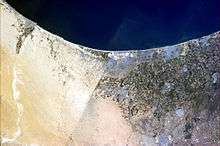
Rafah is the site of the Rafah Border Crossing, the sole crossing between the Gaza Strip and Egypt. Formerly operated by Israeli military forces, control of the crossing was transferred to the Palestinian Authority in September 2005 as part of the larger Israeli withdrawal from the Gaza Strip. A European Union commission began monitoring the crossing in November 2005 amid Israeli security concerns, and in April 2006, Palestinian Authority chairman Mahmoud Abbas's Presidential Guard assumed responsibility for the site on the Palestinian Authority side.[42] On the Egyptian side, the responsibility is assumed by the 750 Border Guards allowed by an agreement of Egypt with Israel. The agreement was signed in November 2005 forced by US pressure, and specifies that it is under security requirements demanded by Israel.
Climate
Köppen-Geiger climate classification system classifies its climate as hot semi-arid (BSh).[43][44]
| Climate data for Rafiah, Gaza Strip | |||||||||||||
|---|---|---|---|---|---|---|---|---|---|---|---|---|---|
| Month | Jan | Feb | Mar | Apr | May | Jun | Jul | Aug | Sep | Oct | Nov | Dec | Year |
| Average high °C (°F) | 17.4 (63.3) |
18.1 (64.6) |
20.5 (68.9) |
23 (73) |
25.8 (78.4) |
28.3 (82.9) |
29.6 (85.3) |
30.5 (86.9) |
29.1 (84.4) |
27.6 (81.7) |
23.8 (74.8) |
19.4 (66.9) |
24.4 (75.9) |
| Daily mean °C (°F) | 12.9 (55.2) |
13.6 (56.5) |
15.6 (60.1) |
18.1 (64.6) |
20.9 (69.6) |
23.6 (74.5) |
25.2 (77.4) |
26 (79) |
24.7 (76.5) |
22.6 (72.7) |
18.7 (65.7) |
14.8 (58.6) |
19.7 (67.5) |
| Average low °C (°F) | 8.4 (47.1) |
9.1 (48.4) |
10.8 (51.4) |
13.3 (55.9) |
16.1 (61.0) |
19 (66) |
20.9 (69.6) |
21.6 (70.9) |
20.3 (68.5) |
17.6 (63.7) |
13.7 (56.7) |
10.2 (50.4) |
15.1 (59.1) |
| Average precipitation mm (inches) | 48 (1.9) |
36 (1.4) |
27 (1.1) |
6 (0.2) |
4 (0.2) |
0 (0) |
0 (0) |
0 (0) |
0 (0) |
8 (0.3) |
39 (1.5) |
53 (2.1) |
221 (8.7) |
| Source: Climate-Data.org (altitude: 45m)[43] | |||||||||||||
| Climate data for Rafah, North Sinai | |||||||||||||
|---|---|---|---|---|---|---|---|---|---|---|---|---|---|
| Month | Jan | Feb | Mar | Apr | May | Jun | Jul | Aug | Sep | Oct | Nov | Dec | Year |
| Average high °C (°F) | 17.2 (63.0) |
18 (64) |
20.3 (68.5) |
22.9 (73.2) |
25.8 (78.4) |
28.2 (82.8) |
29.6 (85.3) |
30.5 (86.9) |
29 (84) |
27.4 (81.3) |
23.7 (74.7) |
19.3 (66.7) |
24.3 (75.7) |
| Daily mean °C (°F) | 12.7 (54.9) |
13.5 (56.3) |
15.4 (59.7) |
18 (64) |
20.8 (69.4) |
23.5 (74.3) |
25.2 (77.4) |
25.9 (78.6) |
24.5 (76.1) |
22.4 (72.3) |
18.6 (65.5) |
14.7 (58.5) |
19.6 (67.3) |
| Average low °C (°F) | 8.2 (46.8) |
9 (48) |
10.6 (51.1) |
13.2 (55.8) |
15.9 (60.6) |
18.8 (65.8) |
20.8 (69.4) |
21.4 (70.5) |
20 (68) |
17.4 (63.3) |
13.5 (56.3) |
10.1 (50.2) |
14.9 (58.8) |
| Average precipitation mm (inches) | 49 (1.9) |
37 (1.5) |
28 (1.1) |
6 (0.2) |
4 (0.2) |
0 (0) |
0 (0) |
0 (0) |
0 (0) |
8 (0.3) |
39 (1.5) |
54 (2.1) |
225 (8.8) |
| Source: Climate-Data.org (altitude: 78m)[44] | |||||||||||||
See also
- Rafah, Egypt
- Gaza–Egypt border
- European Union Border Assistance Mission Rafah
- Israel–Gaza barrier
- Philadelphi Corridor
- Rafah Elementary Co-Ed "B” School
- Rafah Governorate
- Asma al-Ghul
References
- https://www.al-monitor.com/pulse/originals/2019/11/gaza-strip-municipalities-elections-presidents-rafah.html
- "Palestinian Central Bureau of Statistics". Retrieved 15 February 2018.
- Cinderella in Rafah. Al-Ahram, Issue No. 761, 22–28 September 2005
- The Evolution of the Egypt-Israel Boundary: From Colonial Foundations to Peaceful Borders, pp. 3, 9, 18. Nurit Kliot, Boundary and Territory Briefing, Volume 1 Number 8. At Google books
- Razing Rafah — Mass Home Demolitions in the Gaza Strip, pp. 27–28 and 52–66 (PDF text version) on , Summary:. The report on refworld:. Human Rights Watch (HRW), October 2004
- Supplementary Appeal for Rafah. UNWRA, May 2004
- PCHR, Uprooting Palestinian Trees And Leveling Agricultural Land – The tenth Report on Israeli Land Sweeping and Demolition of Palestinian Buildings and Facilities in the Gaza Strip 1 April 2003 – 30 April 2004 On
- Egyptian military doubling buffer zone with Gaza , demolishing nearly 1,220 more homes. Associated Pres, 8 January 2015
- “Look for Another Homeland”. Human Rights Watch, September 2015
- Polybii Historiae [5,80].
- "Rafīah: Gaza Strip; name, map, geographic coordinates". Geographic.org. Retrieved 2014-08-11.
- Zaki, Chehab (2007), Inside Hamas: The Untold Story of Militants, Martyrs and Spies, I.B.Tauris, p. 180, retrieved 2015-09-02
- Barron, 1923, Table V, Sub-district of Gaza, p. 8
- Government of Palestine, Department of Statistics. Village Statistics, April, 1945. Quoted in Hadawi, 1970, p. 46
- Welcome to Rafah Palestine Remembered.
- "Palestinian Population by Locality, Sex and Age Groups in Years". Retrieved 15 February 2018.
- Palestinian Population by Locality and Refugee Status Archived 2008-11-18 at the Wayback Machine. Palestinian Central Bureau of Statistics (PCBS).
- Palestinian Population by Locality, Sex and Age Groups in Years Archived 2008-06-14 at the Wayback Machine Palestinian Central Bureau of Statistics.
- "PCBS] [Palestinian Central Bureau of Statisctics (PCBS) Projected Mid-Year Population for Rafah Governorate by Locality 2004–2006". Retrieved 15 February 2018.
- Polybius 18.51.10 and 28.20.9; Livy 33.40.3 and 35.13.4; Appian, Syriaca 3.13 and 5.18
- Raphia – (Rafah) Studium Biblicum Franciscanum – Jerusalem.
- Joseph Bingham, Origines Ecclesiasticae; Or the Antiquities of the Christian Church and Other Works: In Nine Volumes, Volume 3(Straker, 1843) p 61.
- Dauphin, 1998, p. 953
- Tadrous Y. Malaty, Introduction to the Coptic Orthodox Church OrthodoxEbooks,1993) page 13.
- al‑Biladhuri quoted in le Strange, 1890, p. xix. Al-Biladhuri lists the cities captured by Amr ibn al-'As as Ghazzah (Gaza), Sebastiya (Sebastia), Nabulus, Amwas (Imwas), Kaisariyya (Caesarea), Yibna, Ludd (Lydda), Rafh (Rafah), Bayt Jibrin, and Yaffa (Jaffa). Cited in le Strange, 1890, p. 28
- le Strange, 1890, p. 517
- Hütteroth and Abdulfattah, 1977, p. 150
- Dwyer, 2007, p. 415
- Guérin, 1869, pp. 233-35
- Ludwig Salvator, Archduke of Austria, 1881, p. 54
- Mills, 1932, p. 6
- Government of Palestine, Department of Statistics, 1945, p. 32
- Government of Palestine, Department of Statistics. Village Statistics, April, 1945. Quoted in Hadawi, 1970, p. 88
- Government of Palestine, Department of Statistics. Village Statistics, April, 1945. Quoted in Hadawi, 1970, p. 138
- "Archived copy". Archived from the original on 2013-11-04. Retrieved 2013-08-24.CS1 maint: archived copy as title (link)
- "Rafah (articles/books/maps/cartoons/photographs/video or audio clips)". cosmos.ucc.ie. Retrieved 15 February 2018.
- UN Doc Archived 2007-02-12 at the Wayback Machine A/8389 of 5 October 1971 (h) The continued transfer of the population of the occupied territories to other areas within the occupied territories. Such transfers of population have occurred in the case of several villages that were systematically destroyed in 1967: the population of these villages was either expelled or forced to live elsewhere in the occupied territories. The same practice has been followed in occupied Jerusalem. According to a report in the Jerusalem Post of 17 May 1971, Mr. Teddy Kollek, Israeli Mayor of Jerusalem, stated that 4,000 Arabs had been evacuated from Jerusalem. Likewise, in the case of Gaza, according to reports appearing in several newspapers and in letters addressed by Governments, several thousands of persons were displaced from the three major refugee camps in Gaza. Official Israeli sources have stated that these transfers of population were necessitated by new security measures, such as the construction of wider roads inside the camps in order to facilitate patrolling and the maintenance of law and order in the camps. Most of the persons whose refugee accommodation was destroyed to permit of the construction of these roads were forced to leave for the West Bank and El Arish, while a few were said to have sought refuge with other families inside Gaza. The Special Committee considers that the transfers were unwarranted and that even if the construction of new roads was considered indispensable for the maintenance of law and order, the arbitrary transfer of population was unnecessary, unjustified and in breach of the Fourth Geneva Convention.
- "Archived copy". Archived from the original on 2006-09-14. Retrieved 2007-04-16.CS1 maint: archived copy as title (link)
- Human Rights Watch. Razing Rafah: Mass Home Demolitions in the Gaza Strip. October 2004.
- Razing Rafah, Map 2: Rafah Features. HRW, October 2004
- About Rafah Archived 2009-01-30 at the Wayback Machine Rafah Today.
- Mitch Potter, Something that works: the Rafah crossing, The Toronto Star, May 21, 2006.
- "Climate: Rafiah – Climate graph, Temperature graph, Climate table". Climate-Data.org. Retrieved 2014-02-21.
- "Climate: Rafah – Climate graph, Temperature graph, Climate table". Climate-Data.org. Archived from the original on 2014-02-23. Retrieved 2014-02-21.
Bibliography
- Archduke of Austria, Ludwig Salvator (1881). The Caravan Route between Egypt and Syria. London: Chatto & Windus.
- Barron, J. B., ed. (1923). Palestine: Report and General Abstracts of the Census of 1922. Government of Palestine.
- Dauphin, Claudine (1998). La Palestine byzantine, Peuplement et Populations. BAR International Series 726 (in French). III : Catalogue. Oxford: Archeopress. ISBN 0-860549-05-4.
- Dwyer, Philip (2007). Napoleon -The Path To Power 1769-1799. Bloomsbury. ISBN 0747574901.
- Government of Palestine, Department of Statistics (1945). Village Statistics, April, 1945.
- Guérin, V. (1869). Description Géographique Historique et Archéologique de la Palestine (in French). 1: Judee, pt. 2. Paris: L'Imprimerie Nationale.
- Hadawi, S. (1970). Village Statistics of 1945: A Classification of Land and Area ownership in Palestine. Palestine Liberation Organization Research Center.
- Hütteroth, Wolf-Dieter; Abdulfattah, Kamal (1977). Historical Geography of Palestine, Transjordan and Southern Syria in the Late 16th Century. Erlanger Geographische Arbeiten, Sonderband 5. Erlangen, Germany: Vorstand der Fränkischen Geographischen Gesellschaft. ISBN 3-920405-41-2.
- Mills, E., ed. (1932). Census of Palestine 1931. Population of Villages, Towns and Administrative Areas. Jerusalem: Government of Palestine.
- Polybius 18.51.10 and 28.20.9; Livy 33.40.3 and 35.13.4; Appian, Syriaca 3.13 and 5.18.
- Strange, le, G. (1890). Palestine Under the Moslems: A Description of Syria and the Holy Land from A.D. 650 to 1500. Committee of the Palestine Exploration Fund.
External links
- United Nations Relief and Works Agency for Palestine Refugees in the Near East
- Welcome To The City of Rafah
- Rafah Today, pictures by Palestinian journalist Mohammed Omer
- Rafah Smuggling Tunnels
- Rafah Pundits: Rafah Focused Blog
- Raising Yousuf – Blog by Laila el-Hadad who is a reporter for Aljazeera living in Gaza
- Reports from Rafah
- Interview with Hip Hop Artist Michael Franti – Reporting from Rafah.
- Part A Part B Satellite photos comparing 2001 to 2004.
- Razing Rafah: Mass Home Demolitions in the Gaza Strip – Human Rights Watch
- The Olympia-Rafah Sister City Project – The organization started by people in the communities of Rafah, Gaza, and Olympia, WA
- The Madison-Rafah Sister City Project – A sistering project connecting the communities of Rafah, Gaza, and Madison, WI